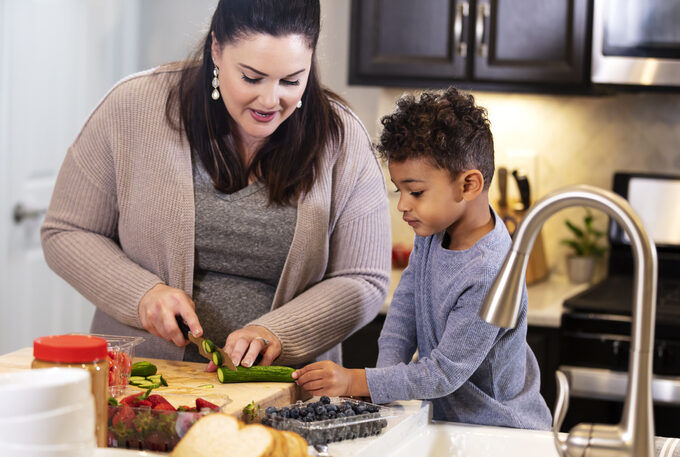There is no doubt that the COVID-19 pandemic has brought about many changes and challenges. Adjusting to new routines and schedules can make it difficult to maintain healthy habits. Remote learning and working from home can impact structure around meals and other activities. While technology has made many things possible in this transition, it has led to increased screen time for many children and families. It’s time to think outside the box and find new and creative ways to unwind and spend time together at home. These strategies are great to keep in mind during colder months at home as well!
Nutrition
Nutrients such as vitamins, minerals, and protein help to boost your immune system and help your body fight against illness.
Minimizing processed foods, high sugar, and fat can also help keep your immune system strong. Higher amounts of sugar and saturated fats (found in high-fat meats and dairy, as well as processed foods) causes inflammation in the body and can weaken immunity.
Increase water intake! Drinking plenty of water throughout the day is important for staying hydrated and flushing out toxins.
Sleep and nutrition go hand and hand. Poor sleep habits can negatively impact food choices and immunity.
Be sure to wash your hands before preparing food and eating! It is recommended to wash your hands with soap and warm water for at least 20 seconds – which is the equivalent to singing “Happy Birthday” twice! According to the Centers for Disease Control and Prevention (CDC), washing your hands is one of the most important actions you can take to prevent you and your family from getting sick.
After washing your hands, it is important to rinse dirt and bacteria from produce before consuming. Here are a few recommendations for cleaning produce:
- Rinse produce before you peel it, to avoid transferring dirt and bacteria from the knife onto the fruit or vegetable.
- Gently rub produce while holding under running water. There’s no need to use soap or a produce wash. The friction of your hands will help to loosen any contaminants.
- Use a clean vegetable brush to scrub firm produce, such as melons and cucumbers.
- Dry produce with a clean cloth or paper towel to further reduce bacteria that may be present.
- Remove the outermost leaves of a head of lettuce or cabbage.
Creating more structure around food at home
More time at home may mean increased temptation to visit the kitchen more frequently. Here are a few tips for creating more structure around food at home:
- Limit tempting foods at home such as sweet treats and chips. Having these tempting foods at home makes it harder to make healthier choices. These foods are also convenient and not very filling, making it easier to consume larger quantities throughout the day.
- Create a schedule for meals and snacks. Allow for 3-4 hours between meals and snacks to avoid “grazing” or constant snacking all day long.
- Prepare healthy snacks in advance and pre-portion into small containers/bags. This makes decision making about snacking simple and easy since the option and portion size is already set up and ready!
- Prepare lunch in advance. This helps limit the temptation to default to snacking instead of eating a balanced meal or reaching for more processed items.
- Plan ahead as much as possible to limit frequency of grocery trips.
Fun food-related ideas.
- Host a cooking competition at home with the family.
- Write meal/snack ideas on popsicle sticks or on folded pieces of paper and have family members pick options out of a jar for the coming week.
- Set up a restaurant experience at home for dinner including a menu of what is being served.
- Try themed dinner meals such as “foods around the world,” “foods that start with the same letter,” “Meatless Monday,” and “salad and sandwich Saturday.”
- Incorporate “make your own” meals such as tacos and personal pizzas.
- Have a picnic in the park, in the back yard or on your living room floor.
Activity
Don’t forget to be active! Physical activity is very important for staying strong and healthy.
Lauren Falini, an exercise physiologist at Nemours Children’s Hospital has answered some frequently asked questions about physical activity below.
Q: What are the benefits of physical activity?
Physical activity has many great benefits, such as making your heart and lungs healthier, which can decrease cardiovascular risk factors. Physical activity can lower your blood pressure and improve your cholesterol. It can also help prevent or improve type 2 diabetes, because your body uses glucose (sugar) when you’re active and makes it easier for your body to absorb glucose. Mental health benefits of physical activity include better mood, improved cognitive function, and better quality of sleep, as well as improved confidence.
Q: How much physical activity is recommended for kids and teens?
Children and teens between the ages of 6 and 17 should be physically active for at least 60 minutes each day doing moderate to vigorous activity. Most of this activity should be aerobic — meaning walking, running, biking, dancing, and other activities that increase their heart rate. Vigorous activity, that makes their heartbeat much faster, is recommended three times a week, like running when playing sports. Three times a week kids should also do muscle building and bone strengthening activity. Muscle strengthening activities would be climbing and hanging on playground equipment or doing exercises like push up and crunches. Bone strengthening activities include jumping and running.
Q: What counts as physical activity?
Physical activity is any movement that is completed in a day that requires an expenditure of energy. Some examples include, playing outside, playing on the playground, riding bikes, scooters, playing sports, jumping rope, and dancing. Physical activity can also include raking leaves, shoveling snow, vacuuming, taking the stairs, walking the dog or walking to the bus stop.
Q: Do you need special equipment or a gym membership?
No! You do not need any fancy equipment or a gym membership in order to stay active. You can go to the park or playground, walk outside, do jumping jacks, ride your bike, play football, have a catch, play tennis, and much more.
You can also exercise inside. There are numerous exercise videos available for free on YouTube and are also available through Amazon Prime and cable tv. All of these options provide great workout videos that require little to no equipment. Some examples are yoga, Zumba. kickboxing, and dance videos. There are also active exercise video games such as Just Dance, Zumba, and Ring Fit Adventures.
Q: Any recommended health apps or programs?
There are many great fitness apps out there to help children and teens be physically active. My favorites are activity tracking apps. There are two types of apps; gps and step counter apps. GPS apps track distance covered during a workout and can be used to record exercises such as walking, jogging, and biking. Runkeeper, Map My Walk, and Strava are a few examples of GPS apps. Step counter apps count how many steps you take in a day. Some phones come with these apps already programmed, for example, the health app on iPhones. Even if your phone does not come with this feature there are a lot of other free options in app stores. Sworkit Kids and Daily Workouts are two other applications that offer workouts that can be done at home even with little space and no equipment.
Q: How can families balance screen time and physical activity?
A great way for families to balance screen time and physical activity is to schedule it or make it part of a daily routine. Children are most likely to be active right after school, so encourage your child to play outside when they get home or plan to do an indoor activity if the weather is not ideal. To help kids stick with this routine, limit screen time after school. This helps with the temptation to avoid or delay exercise because they want to play videogames or watch TV. Aim to save screen time for after physical activity, homework, chores, and dinner are completed. It is for free time at the end of the day when everything you need to accomplish is done.
Q: How can families become more fit together?
Make exercising a fun family activity, it is more fun when everyone plays! Consider playing a sport together in your yard or nearby park such as basketball, soccer, tag, or have a catch with a football or baseball. If you have children of different ages, try to play the sport in a way that is fun for everyone. Try taking a family walk, hike, or bike ride. Consider ending walks with something fun such as walking to a playground or park or playing a fun game such as tag or a water balloon fight! It’s important for all family members to encourage each other to stay active to meet their fitness goals.
Q: Any advice for maintaining consistency with exercise?
Setting a routine and limiting screen time are the best way to help with consistency. The routine that seems to work best is physical activity, homework, and chores after school.
Learn More
Mindful Snacking (Nemours Blog)
Food Prep During Extended Stays at Home (Nemours Blog)
Physical Activity: A Key Ingredient to Keeping Kids at a Healthy Weight (Nemours Blog)



